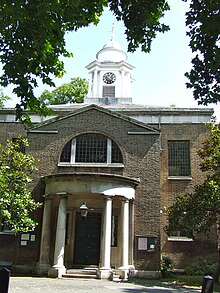St Mary on Paddington Green Church
| St Mary on Paddington Green | |
|---|---|
 |
|
| 51°31′13″N 0°10′31″W / 51.5204°N 0.1753°W | |
| Location | Little Venice, London, W2 1SP |
| Country | England |
| Denomination | Church of England |
| Churchmanship | Anglo-Catholic |
| Website | parishoflittlevenice |
| Architecture | |
| Status | Active |
| Functional status | Parish Church |
| Administration | |
| Parish | Little Venice |
| Deanery | Westminster Paddington |
| Archdeaconry | Archdeaconry of Charing Cross |
| Episcopal area | Two Cities (London and Westminster) |
| Diocese | Diocese of London |
| Clergy | |
| Bishop(s) | The Rt Revd Richard Chartres (Bishop of London) |
| Vicar(s) | Fr Gary Bradley |
| Honorary priest(s) | Fr Anthony Speakman |
| Laity | |
| Director of music | Jonathan Cunliffe |
| Churchwarden(s) | Alex Wrottesley and Tim Telfer |
| Verger | Peggy Windsor |
St Mary on Paddington Green is an Anglican church in the Parish of Little Venice, London and forms part of Paddington Green conservation area. It stands on the junction of Edgware Road and Harrow Road, overlooking Westway.
It is the third church on the site – once forming a centrepiece of the ancient Paddington and Lilestone villages. John Donne preached his first sermon in the original church, while William Hogarth was married in the second.
The current church is Georgian and was commissioned in 1788 and consecrated in 1791. Designed by John Plaw, and with a floorplan in the shape of a Greek Cross, it is built in yellow brick and dressed with white stone. It is Plaw's only confirmed surviving building in the UK, apart from Belle Isle on Windermere. A further building in Romford, known as The Round House, has been attributed to him. John Plaw later worked in Southampton before emigrating to Canada, where he designed several public and private buildings.
The church was substantially altered in the 19th century, but was restored by architect Raymond Erith in the early 1970s. The church is notable for its fine monuments to local luminaries, including sculptor Joseph Nollekens and lexicographer Peter Mark Roget.
Adjoining St Mary’s Churchyard was converted to a public park in the 1890s and is now known as St Mary’s Gardens. It consists of grassland with scattered trees. The grave of well-known 18th-century actress Sarah Siddons is located towards the northern end. Some other gravestones from the former graveyard are stacked against the west wall of the Gardens.
...
Wikipedia
